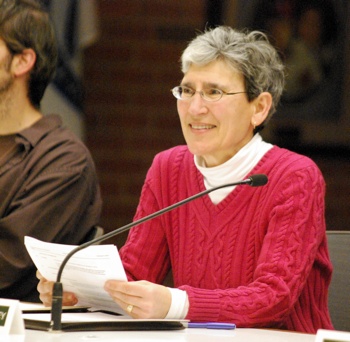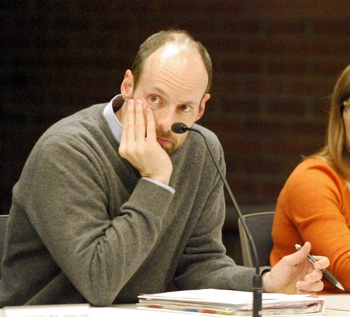Greenbelt Commission Works on Outreach
Ann Arbor greenbelt advisory commission meeting (May 1, 2014): During a meeting that lasted less than an hour, commissioners were briefed on a draft communications plan aimed at raising awareness of the city’s greenbelt program.

Stephanie Buttrey, a member of the Ann Arbor greenbelt advisory commission’s communications and outreach committee. (Photos by the writer.)
The hope is to increase support of the program among Ann Arbor taxpayers, landowners who might be eligible to preserve their property as part of the greenbelt, and elected officials and policymakers at the local, regional and federal levels.
The committee is also thinking longer-term, looking at what might happen when the 30-year millage expires. The millage that supports the greenbelt program was passed by voters in 2003. The 0.5 mill tax for land acquisition is called the open space and parkland preservation millage. On the summer tax bill, the line item appears as CITY PARK ACQ.
The committee will continue its work and eventually bring forward a completed plan for the full commission to approve.
Also on May 1, commissioners received a brief update from Ginny Trocchio, who provides staff support for the greenbelt program. She reported on proposed federal legislation related to tax incentives for donating conservation easements. Landowners who want to donate easements or who agree to sell their easements for less than market value have in the past received a tax deduction. But legislation allowing for that deduction expired at the end of 2013. Congress is considering an extension for 2014 and 2015, Trocchio said.
The meeting also included a closed session to discuss possible land acquisitions, which lasted about 30 minutes. The topic of land acquisition is one allowed as an exemption by the Michigan Open Meetings Act for a closed session. When commissioners emerged, they voted on one resolution that will be forwarded to the city council – a recommendation to pursue the purchase of development rights on a property in Pittsfield Township, using matching funds that Cherry Republic had previously donated to the city.
Communications & Outreach
Three commissioners serve on a committee for communications and outreach: Stephanie Buttrey, John Ramsburgh, and Jean Cares. They volunteered to work on the committee at GAC’s Jan. 2, 2014 meeting.
Since then, they’ve developed a draft communications plan with two primary goals: (1) increasing public awareness of and support for the greenbelt, and (2) increasing landowner support for and participation in land preservation within the greenbelt.
At the May 1 meeting, Buttrey gave an update on the plan. The committee had brainstormed about how to get the greenbelt program’s message out to the community, she said. Many people don’t know about the program, or know about it in only a very general way. Sometimes, people’s reaction is to ask why the city is spending taxpayer money outside of Ann Arbor, she noted.
Because of misinformation or a lack of information, she said, the committee was formed to communicate the greenbelt’s mission and to come up with answers to frequently asked questions – and in general, to figure out how to get the message out about what the greenbelt program does.
The draft plan calls for using a combination of earned, paid and social media to strengthen public and landowner support for the greenbelt. Target audiences include Ann Arbor taxpayers, existing and potential landowner participants in the program, and elected officials and policymakers at the local, regional and federal levels. [.pdf of draft plan]
Existing outreach efforts include an annual public forum at the Ann Arbor District Library that features a panel discussion of landowners who’ve participated in the program. A bus tour of greenbelt properties is held each year, and the greenbelt is typically promoted at events throughout the year, like the HomeGrown Fest and Mayor’s Green Fair.
Potential efforts listed in the draft plan include:
- Develop a FAQ for commission members and the public.
- Create a greenbelt Facebook page and Twitter account, as well as a presence on the city’s Facebook and Twitter pages.
- Form a greenbelt-exclusive listserv with the target goal of 500 emails in 2014, to receive monthly updates.
- Design a tri-fold brochure for distribution.
- Implement a registry program for potential landowners.
- Partner with local businesses that support local agriculture, as a possible alternate source of matching funds.
- Expand public outreach through event tabling, a speaker’s bureau, and other efforts.
- Create a PowerPoint presentation that can be used for making presentations.
- Develop driving and biking maps of greenbelt properties that can be posted online.
- Explore possible birding opportunities.
Ginny Trocchio, who provides staff support for the greenbelt program, reported that she and Sumedh Bahl – the city’s community services area administrator – have met with the city’s communications staff, who’ll be attending the next committee meeting to help brainstorm about resources that could be used. The intent is to flesh out more details of the plan, create a timeline for implementation, and bring it back to GAC for approval, she said.
The next communications and outreach committee meeting is on May 27 at 4 p.m. in the first floor conference room at city hall. “Any other commissioners are welcome to join us,” Buttrey said.
Buttrey also suggested developing an “elevator speech” – with the intent to have a standard, concise way of explaining the greenbelt program and the role of commissioners.
Ramsburgh noted that the committee is also thinking longer-term about the program, and what will happen when the millage expires.
The 30-year millage that supports the greenbelt program was passed by voters in 2003. The 0.5 mill tax for land acquisition is called the open space and parkland preservation millage. On the summer tax bill, the line item appears as CITY PARK ACQ.
Outcome: This was not a voting item.
Staff Update
Ginny Trocchio gave an update about grants from the former USDA Farm and Ranchland Protection Program (FRPP). By way of background, this program was repealed under the new federal Farm Bill of 2014. It was replaced by the Agricultural Conservation Easement Program.

Ginny Trocchio, right, talks with GAC chair Catherine Riseng before the start of the May 1 meeting. Trocchio is an employee of The Conservation Fund, which is under contract with the city to provide staff support for the greenbelt program.
Applications for this new program are now being accepted until June 6, Trocchio reported. In the past, Ann Arbor’s greenbelt program has been successful in securing FRPP grants as matching funds for land preservation. Trocchio said she’s now working on possible properties that might be eligible for grants under the new program.
Trocchio also updated commissioners on legislation that’s pending in Congress related to tax incentives for donating conservation easements. Landowners who want to donate easements or who agree to sell their easements for less than market value have previously been able to receive a tax deduction.
Prior to 2006, the income deduction that a landowner could take for donating an easement was 30% of their adjusted gross income. They couldn’t take that deduction all in one year, but could carry it forward for an additional five years.
So a landowner earning $50,000 a year who made a donation valued at $1 million could take a $15,000 deduction annually for six years – for a total deduction of $90,000.
In 2006, Congress passed legislation that increased that deduction from 30% of adjusted gross income to 50%, and allowed landowners to carry the deduction forward for an additional 15 years. The change allowed landowners to take a greater overall deduction. So the same landowner earning $50,000 and making a $1 million donation could receive total deductions of $400,000 over 16 years. The 2006 legislation also allowed for certain qualified farmers to deduct 100% of their adjusted gross income. A qualified farmer is someone who makes at least 50% of their household income from a farm operation.
These enhanced incentives expired at the end of 2013, Trocchio reported. Now, however, Congress is considering an extension in 2014 and 2015. She told commissioners that she’d keep them posted on any new developments. The land trust community is hoping to make these incentives permanent, she said.
Land Acquisition
Most meetings of the greenbelt advisory commission include a closed session to discuss possible land acquisitions. The topic of land acquisition is one allowed as an exemption by the Michigan Open Meetings Act for a closed session.
On May 1, commissioners met in a closed session that lasted about 30 minutes, then emerged and voted on one resolution that will be forwarded to the city council.
Before appearing on the city council’s agenda, details of proposed greenbelt acquisitions are not made public. Parcels are identified only by their application number, with the first four numbers signifying the year in which the application was made.
On May 1, commissioners voted on a resolution recommending that the city council move forward with the purchase of development rights on a property identified in application #2013-05. The resolution also recommended a partnership agreement with Pittsfield Township and an allocation of $5,200 from the contribution made to the city by Cherry Republic. That amount would be used as matching funds in the deal.
Outcome: The resolution passed unanimously, without discussion.
Next meeting: Thursday, June 5, 2014 at 4:30 p.m. in the second-floor council chambers at city hall, 301 E. Huron. [Check Chronicle event listings to confirm date] The meetings are open to the public and include two opportunities for public commentary.
Present: Shannon Brines, , Stephanie Buttrey, Jean Cares, Jennifer Fike, John Ramsburgh, Catherine Riseng, Christopher Taylor. Staff: Ginny Trocchio.
Absent: Peter Allen, Archer Christian.
The Chronicle survives in part through regular voluntary subscriptions to support our coverage of publicly-funded entities like the city’s greenbelt program. If you’re already supporting The Chronicle, please encourage your friends, neighbors and coworkers to do the same. Click this link for details: Subscribe to The Chronicle.





Did the ballot language for the Greenbelt tax make any mention of anything other than the Greenbelt itself? E.g., zoning in Ann Arbor, “Density”, urban land use, demographics, infrastructure? Anything at all, other than the millage rate, the intended use of the money raised, and details of the the Greenbelt Commission?
Re: [1]
Here’s the ballot language, extracted from the resolution recorded in the minutes of the Aug. 18, 2003 city council meeting when the council voted to place the request on the ballot:
The outreach effort is a very worthy priority, and I’m glad GAC is working on it. City taxpayers have already been rewarded with many excellent properties permanently preserved as farmland and/or open space and many (most?) of them don’t know it.
My experience is that a vanishingly small percentage of A2 citizens have even the vaguest idea the Greenbelt exists or what GAC does.
Common misconceptions are that the city owns the farms from which it has purchased the development rights (they remain private property) and that there is no new construction allowed within the Greenbelt boundary.
A couple suggestions for GAC:
- Change the description on the tax bill from “CITY PARK ACQ.” to “GREENBELT ACQ.” The current description is confusing and some might argue misleading as well.
- According to the ballot language the goal was “to provide funds for preservation and protection of parkland, open space, natural habitats and City sourcewaters by the acquisition and management of land and land rights both within and outside the City of Ann Arbor”
What has been the spending breakdown for each category listed on the ballot? – parkland, open space, natural habitats and City sourcewaters? Are they equally weighted? If not what is the rationale for favoring one over the other? Perhaps a color coded map of the properties for each category would help.
I agree with Re:[3]that the outreach program should be a priority.
Larry Baird